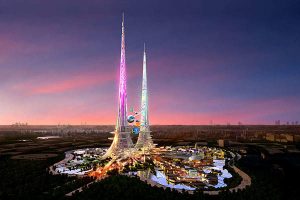Floating Cities around the World

Over the past decade, we have seen dozens of new designs for floating cities appear on the Internet, as a result of contests, or someone’s independent creative endeavor. A gorgeous example is the famous Manta Ray design from popular French architect Jacques Rougerie.
The Manta Ray would work as an academic city. Its capacity would be for 7,000 people, and it would be run on 100% renewable energy, creating no waste.
There is another design for Silt Lake City, which would be located in Lake Nasser, Egypt. We can also look at Green Float, a utopic city, designed by Japanese architects, to house one million people. The floating city would connect islands and their vertical farms, with plus commercial and residential cities.
Arguably, the most beautiful design is The Lilypad, created by Vincent Callebaut. Each of these zero-emission floating communities would house up to 50,000 people. They are envisioned as the future home for climate change refugees.
There is also Harvest City, which was developed by architect E. Kevin Schopfer, after Haiti was hit by a devastating earthquake in 2010. This innovative floating city design is expected to bolster the country’s recovery, by connecting hundreds of floating modules where residents can live.
Other examples include Noah’s Ark, from Serbian designers Aleksandar Joksimovic, and Jelena Nikolic, another self-sustaining floating city; Remistudio Ark, a massive hotel complex that can be self-sustainable above water; X SEA TY, a proposed floating city that works to transform carbon dioxide polluting environments by using biochemical energy algae; and many more. Some of these cities would be assembled like beehives, so that they can be transported to meet demand.
If you think these projects are too far out, consider the following. In January 2017, the French Polynesian government signed an agreement with the Seasteading Institute of San Francisco. The agreement is to develop the world first floating city in the South Pacific. Construction was scheduled to start as early as 2019.
There are many more futuristic building designs. They may not provide the most natural environment for humans to live in, but they demonstrate the power of technology, and the immense capacity we have to sustain human life on earth.
If all this seems to hard to believe, take a look at the Poseidon Undersea Resort. A five star resort underwater, with a restaurant, gym, spa, and a nine-hole golf course. The project was due to open in 2008, and has an estimated 150,000 potential guests on its waiting list. That being said, you can stay in underwater hotel rooms, dance in underwater clubs, and dine in underwater restaurants in Dubai, Zanzibar, the Maldives, and the United States.
Previous Section:
Next Section:
Acknowledgments



